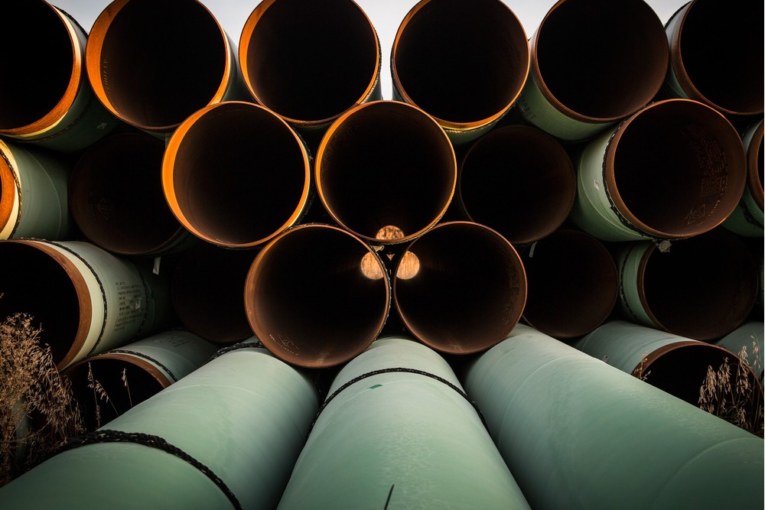
Take two steps forward, a half-step back.
The Canadian pipeline dance marathon never seems to end and the music is always playing.
But the country is inching closer to building new oil pipelines as current ones run full and domestic prices suffer.
Ever so slowly, progress is being made.
“We are getting positive momentum,” said Chris Bloomer, CEO of the Canadian Energy Pipeline Association.
“It is painful at times, but there is optimism that at some point they’re going to go.”
On Thursday, two key developments unfolded in Canada’s long-running pipeline logjam, coming after a half-step back on Wednesday.
TransCanada Corp. said it has commercial support for its US$8-billion Keystone XL pipeline, which would run from the Hardisty area south to Steele City, Neb.
Later in the day, Kinder Morgan won a pivotal ruling from the National Energy Board to streamline the dispute-resolution process to obtain municipal and provincial permits needed to build its Trans Mountain expansion.
Both are hopeful signs for a Canadian industry that has been missing out on the recent oil price rally due to deepening discounts for domestic heavy crude.
For TransCanada, it would have been more of a surprise if the Calgary-based company said it didn’t have enough producers lined up to move oil on the 830,000-barrel-a-day Keystone XL line.
There should be ample demand for the project as oilsands production continues to grow, and more crude is shipped by rail.
TransCanada announced it has secured firm 20-year contracts to transport about 500,000 barrels per day on KXL, “positioning the proposed project to proceed.”
Thursday’s news is not a full-fledged final investment decision to start building, although the company is one step closer to making that call.
“I would expect them to have an affirmative decision, if not by end of January, then by the end of next month,” said retired TransCanada executive Dennis McConaghy.
“You’ve got both Donald Trump and Rachel Notley aligned with this project. That’s an extraordinary accomplishment and it speaks to the inherent economic viability of the project.”
Companies such as Canadian Natural Resources and Suncor Energy have already signalled their commitment to ship barrels on the cross-border pipeline. The Alberta government also agreed to transport 50,000 barrels a day of oil that the province collects from producers in place of royalties.
Alberta said it made the decision because the project will help shrink the differential affecting Canadian heavy oil that is costing companies and the province billions of dollars in lost revenue.
Some will argue the government’s commitment is a subsidy, but that won’t get much political traction. The government has a duty to maximize the value it can get from these barrels, and for all oilsands resources.
If the provincial agreement helps build a pipeline and shrinks the light-heavy oil differential, the decision is “a sensible thing to do,” said economist Trevor Tombe at the University of Calgary.
A number of factors are now lining up in favour of Keystone XL being built, although nothing should be taken for granted, given the project was seemingly DOA a couple of years ago.
While TransCanada edged forward Thursday, the Trans Mountain expansion project also made some headway.
The National Energy Board ruled in favour of Kinder Morgan’s request to set up a generic process to quickly handle future disputes over construction permits needed from municipal and provincial governments.
The decision won’t win many friends in the B.C. government, which opposes the project, but it will be welcomed in Alberta.
Trans Mountain is favoured by the Notley government because it would triple the amount of oil moving on an existing line to the west coast. The project would give Canada more access to growing export markets, particularly in Asia.
The ruling comes after Kinder Morgan warned Wednesday the project is now a full year behind schedule, with an expected startup in December 2020.
More concerning is the fact the company hasn’t fully opened up the project’s spending spigot yet, even with regulatory and federal approvals in hand.
Kinder Morgan CEO Steve Kean told a conference call that until the U.S. firm receives greater clarity on permitting, it wouldn’t fully open the taps on the $7.4-billion development.
“We do need to see that there’s a process in place … so that once we start, we can be confident that we are going to finish,” he said.
From a risk management point of view, it makes perfect sense. Who wants to invest billions of dollars in a project that might not cross the finish line?
For Canadian producers who watched the light-heavy oil price differential widen to more than $29.64 a barrel on Wednesday, new pipeline capacity can’t come fast enough.
Nick Schultz with the Canadian Association of Petroleum Producers pointed out current pipelines in Western Canada — with a capacity of about four million barrels a day — are already full.
“We needed those pipelines now,” he said of the proposed developments. “That’s a negative for everyone in Alberta and, frankly, negative for Canada as a whole.”
It’s sometimes tough to see, but Canada has made strides towards getting new pipelines constructed.
The industry needs to see more certainty before the pipeline dance can finally stop, and there are no guarantees ahead.
But the days of tripping over our feet may finally be coming to an end, one painful step at a time.
Chris Varcoe is a Calgary Herald columnist.
You can read more of the news on source
